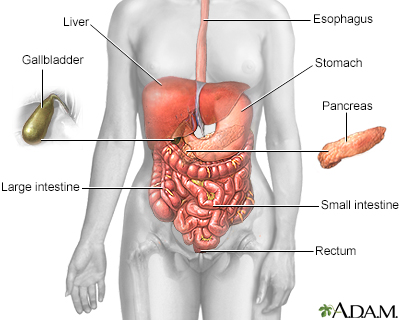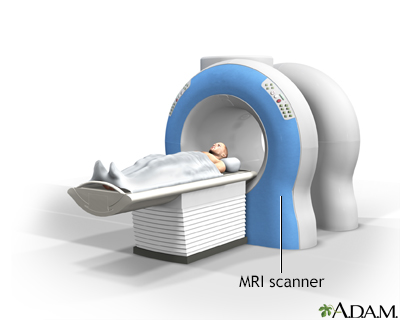Abdominal MRI scan
Nuclear magnetic resonance - abdomen; NMR - abdomen; Magnetic resonance imaging - abdomen; MRI of the abdomen; Liver MRI - abdomen; Pancreas MRI - abdomen; Kidney MRI - abdomen
An abdominal magnetic resonance imaging scan is an imaging test that uses powerful magnets and radio waves. The waves create pictures of the inside of the belly area. This test does not use radiation (x-rays).
Single magnetic resonance imaging (MRI) images are called slices. The images can be stored on a computer, viewed on a monitor, printed on film or scanned to a disk. One exam produces dozens or sometimes hundreds of images.
Images


How the Test is Performed
You may be asked to wear a hospital gown or clothing without metal zippers or snaps (such as sweatpants and a t-shirt). Certain types of metal can cause blurry images.
You will lie on a narrow table. The table slides into a large tunnel-shaped scanner.
Some exams require a special dye (contrast). Most of the time, the dye is given during the test through a vein (IV) in your hand or forearm. The dye helps the radiologist see certain areas more clearly.
During the MRI, the person who operates the machine will watch you from another room. The test lasts about 30 to 60 minutes, but it may take longer.
How to Prepare for the Test
You may be asked not to eat or drink anything for 4 to 6 hours before the scan.
Tell your health care provider if you are afraid of close spaces (have claustrophobia). You may be given a medicine to help you feel sleepy and less anxious. Your provider may also suggest an open MRI, in which the machine is not as close to your body.
Before the test, tell your provider if you have:
- Artificial heart valves
- Brain aneurysm clips
- Heart defibrillator or pacemaker
- Inner ear (cochlear) implants
- Kidney disease or dialysis (you may not be able to receive contrast)
- Recently placed artificial joints
- Certain types of vascular stents
- Worked with sheet metal in the past (you may need tests to check for metal pieces in your eyes)
Because the MRI contains strong magnets, metal objects are not allowed into the room with the MRI scanner. Avoid carrying items such as:
- Pocketknives, pens, and eyeglasses
- Watches, credit cards, jewelry, and hearing aids
- Hairpins, metal zippers, pins, and similar items
- Removable dental implants
How the Test will Feel
An MRI exam causes no pain. You may get medicine to relax you if you have a problem lying still or are very nervous. Moving too much can blur MRI images and cause errors.
The table may be hard or cold, but you can ask for a blanket or pillow. The machine makes loud thumping and humming noises when turned on. You can wear ear plugs to help reduce the noise.
An intercom in the room allows you to speak to someone at any time. Some MRI facilities have televisions and special headphones to help you pass time.
There is no recovery time, unless you were given a medicine to help you relax. After an MRI scan, you can go back to your normal diet, activity, and medicines.
Why the Test is Performed
An abdominal MRI provides detailed pictures of the belly area from many views. It is often used to clarify findings from earlier ultrasound or CT scan exams.
This test may be used to look at:
- Blood flow in the abdomen
- Blood vessels in the abdomen
- The cause of abdominal pain or swelling
- The cause of abnormal blood test results, such as liver or kidney problems
- Lymph nodes in the abdomen
- Masses in the liver, kidneys, adrenals, pancreas, or spleen
MRI can distinguish tumors from normal tissues. This can help your provider know more about the tumor such as size, severity, and spread. This is called staging.
In some cases it can give better information about masses in the abdomen than CT.
What Abnormal Results Mean
An abnormal result may be due to:
- Abdominal aortic aneurysm
- Abscess
- Cancer or tumors that involves the adrenal glands, liver, gallbladder, pancreas, kidneys, ureters, intestines or bladder
- Enlarged spleen or liver
- Gallbladder or bile duct problems
- Hemangiomas
- Hydronephrosis (kidney swelling from the backflow of urine)
- Kidney infection
- Kidney damage or diseases
- Kidney stones
- Enlarged lymph nodes
- Obstructed inferior vena cava
- Portal vein obstruction (liver)
- Blockage or narrowing of the arteries that supply the kidneys
- Renal vein thrombosis
- Kidney or liver transplant rejection
- Cirrhosis of the liver
- Spread of cancers that began outside the belly
Risks
MRI does not use ionizing radiation. No side effects from the magnetic fields and radio waves have been reported.
The most common type of contrast (dye) used is gadolinium. It is very safe. Allergic reactions are rare but can occur. If you have a history of severe allergic reactions to other medicines you should notify your doctor. In addition, gadolinium can be harmful to people with kidney problems who need dialysis. Tell your provider before the test if you have kidney problems.
The strong magnetic fields created during an MRI can cause heart pacemakers and other implants not to work as well. The magnets can also cause a piece of metal inside your body to move or shift.
Related Information
MRINoninvasive
CT scan
Arteriogram
SVC obstruction
Renal vein thrombosis
Acute arterial occlusion - kidney
Hydronephrosis of one kidney
Acute tubular necrosis
Transplant rejection
Pancreatic cancer
Tumor
Cancer
Lymphofollicular hyperplasia
Splenomegaly
Bile
Gallstones
Abscess
Red birthmarks
Abdominal aortic aneurysm
Acute kidney failure
Adenomyosis
Atheroembolic renal disease
Renal pelvis or ureter cancer
Chronic kidney disease
Cystinuria
Hydatidiform mole
Injury - kidney and ureter
Insulinoma
Pancreatic neuroendocrine tumors
Autosomal dominant tubulointerstitial kidney disease
Multiple endocrine neoplasia (MEN) II
Multiple endocrine neoplasia (MEN) I
Kidney stones
Ovarian cancer
Pheochromocytoma
Aortic aneurysm repair - endovascular
Abdominal aortic aneurysm repair - open
Aortic aneurysm repair - endovascular - discharge
References
Al Sarraf AA, McLaughlin PD, Maher MM. Current status of imaging of the gastrointestinal tract. In: Adam A, Dixon AK, Gillard JH, Schaefer-Prokop CM, eds. Grainger & Allison's Diagnostic Radiology: A Textbook of Medical Imaging. 7th ed. Philadelphia, PA: Elsevier; 2021:chap 18.
Carucci LR. Diagnostic imaging procedures in gastroenterology. In: Goldman L, Cooney KA, eds. Goldman-Cecil Medicine. 27th ed. Philadelphia, PA: Elsevier; 2024:chap 119.
Mileto A, Boll DT. Liver: normal anatomy, imaging techniques, and diffuse diseases. In: Haaga JR, Boll DT, eds. CT and MRI of the Whole Body. 6th ed. Philadelphia, PA: Elsevier; 2017:chap 43.
BACK TO TOPReview Date: 7/15/2024
Reviewed By: Jason Levy, MD, FSIR, Northside Radiology Associates, Atlanta, GA. Also reviewed by David C. Dugdale, MD, Medical Director, Brenda Conaway, Editorial Director, and the A.D.A.M. Editorial team.

Health Content Provider
06/01/2025
|
A.D.A.M., Inc. is accredited by URAC, for Health Content Provider (www.urac.org). URAC's accreditation program is an independent audit to verify that A.D.A.M. follows rigorous standards of quality and accountability. A.D.A.M. is among the first to achieve this important distinction for online health information and services. Learn more about A.D.A.M.'s editorial policy, editorial process and privacy policy. A.D.A.M. is also a founding member of Hi-Ethics. This site complied with the HONcode standard for trustworthy health information from 1995 to 2022, after which HON (Health On the Net, a not-for-profit organization that promoted transparent and reliable health information online) was discontinued. |
The information provided herein should not be used during any medical emergency or for the diagnosis or treatment of any medical condition. A licensed medical professional should be consulted for diagnosis and treatment of any and all medical conditions. Links to other sites are provided for information only -- they do not constitute endorsements of those other sites. © 1997- 2025 A.D.A.M., a business unit of Ebix, Inc. Any duplication or distribution of the information contained herein is strictly prohibited.
